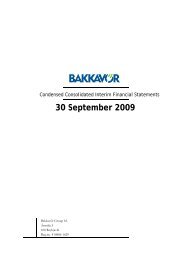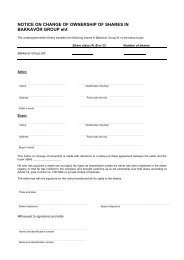Download our latest Annual Report - Bakkavor
Download our latest Annual Report - Bakkavor
Download our latest Annual Report - Bakkavor
Create successful ePaper yourself
Turn your PDF publications into a flip-book with our unique Google optimized e-Paper software.
BAKKAVOR ANNUAL REPORT AND ACCOUNTS 2012<br />
notes to the consolidated financial statements<br />
continued<br />
3<br />
CRITICAL ACCOUNTING JUDGEMENTS AND KEY SOURCES OF ESTIMATION UNCERTAINTY CONTINUED<br />
Going concern<br />
The Directors, in their detailed consideration of going concern, have reviewed the Group’s future cash forecasts and revenue projections, which they<br />
believe are based on prudent market data and past experience, and believe, based on those forecasts and projections, that it is appropriate to prepare<br />
the financial statements of the Company and the Group on a going concern basis.<br />
In arriving at this conclusion the Directors considered the Group’s financing arrangements, which comprise £350 million of seven-year listed bonds<br />
issued in February 2011 and £350 million of bank facilities committed to June 2014. The Company is in advanced discussions with its lenders regarding<br />
the refinancing of these bank facilities. Both the Company and its lenders are committed to the refinancing of both the Term loan and Revolving Credit<br />
Facility and the Board is confident of announcing new financing arrangements in the near future. Importantly, the Group’s liquidity remains particularly<br />
strong with £83.8 million of facilities undrawn as at 29 December 2012.<br />
The existing bank facilities are subject to a series of covenants set by the lenders. Financial covenants are measured quarterly and include an<br />
assessment of leverage (the ratio of net debt to EBITDA, being earnings before interest, tax, depreciation and amortisation); cash flow cover (the ratio<br />
of finance charges to cash generated from operations); interest cover (the ratio of finance charges to EBITDA) and capital expenditure limits. The key<br />
financial covenant is leverage; this was re-set earlier in the year following the successful restructuring of the Company’s parent. Under the revised<br />
covenant, leverage must be less than 5.75 times at the 2012 financial year-end and less than 5.0 times at the 2013 financial year-end. At 29 December<br />
2012 the leverage ratio of net debt to EBITDA was 4.9 times. At the date of this report the Group has complied in all respects with the terms of its<br />
borrowing agreements, including its financial covenants and forecasts to continue to do so.<br />
The Group believes it is adequately placed to manage covenant compliance successfully despite the challenging macroeconomic environment.<br />
In the event that conditions worsen, the Group has the flexibility to react by accessing additional working capital arrangements that we have already<br />
agreed with key stakeholders. Further actions available to management may include a reduction to <strong>our</strong> capital expenditure programme and supply<br />
chain improvements. Consequently the Directors have a reasonable expectation that the Company and the Group have adequate res<strong>our</strong>ces<br />
to comply with these covenants and meet their liabilities as they fall due for a period of at least 12 months from the date of approval of the financial<br />
statements. For this reason they continue to adopt the going concern basis in preparing the financial statements.<br />
Impairment of goodwill and other intangible assets<br />
The recoverable amount of CGUs are determined based on the higher of net realisable value and value-in use calculations. These calculations require<br />
the use of estimates. The Group has considered the impact of the assumptions used on the calculations and has conducted sensitivity analysis on the<br />
impairment tests of the CGUs carrying values. See notes 15 and 16 for further details.<br />
Fair value of derivatives and other financial instruments<br />
Derivative financial instruments and certain other financial assets are recorded at fair value in the statement of financial position. The fair value of<br />
the financial instruments that do not have quoted market prices requires significant judgement and estimates. The Directors use their judgement in<br />
selecting an appropriate valuation technique for these financial instruments. Valuation techniques commonly used by market practitioners are applied.<br />
For derivative financial instruments, assumptions are made based on quoted market rates adjusted for specific features of the instrument. Other<br />
financial instruments are valued using a discounted cash flow analysis based on assumptions supported, where possible, by observable market<br />
prices or rates. The estimation of fair value of unlisted shares includes some assumptions not supported by observable market prices or rates. These<br />
assumptions are based on past and expected future performance. Details of the assumptions used and of the results of sensitivity analyses regarding<br />
these assumptions are disclosed in note 29.<br />
Pensions<br />
The Group maintains a number of defined benefit pension plans for which it has recorded a pension asset or liability. The pension asset/liability<br />
is based on an actuarial valuation that requires a number of assumptions including discount rate, mortality rates and actual return on plan assets<br />
that may necessitate material adjustments to this asset/liability in the future. The assumptions used by the Group are the best estimates based on<br />
historical trends and the composition of the work force. Details of the principal actuarial assumptions used in calculating the recognised asset/liability<br />
for the defined benefit plan are given in note 36.<br />
Recognition of deferred tax assets and current tax provision<br />
The recognition of deferred tax assets is based upon whether it is probable that sufficient and suitable taxable profits will be available in the future<br />
against which the reversal of temporary differences can be deducted. Where the temporary differences related to losses, the availability of the losses<br />
to offset against forecast taxable profits is also considered. Recognition therefore involves judgement regarding the future financial performance of<br />
the particular legal entity or tax group in which the deferred tax asset has been recognised.<br />
The Group had unrecognised deferred tax assets as a result of unused tax losses of £40.5 million (2011: £17.9 million), available for offset against<br />
future profits. Deferred tax assets are not recognised on the losses carried forward to the extent that it is not probable that the losses will be utilised.<br />
The Group operates in various countries and its income tax returns are subject to audit and adjustment by local tax authorities. The nature of the<br />
Group’s tax exposures is often complex and subject to change and the amounts at issue can be substantial. The Group develops an estimate of the<br />
potential tax liability based on the tax positions taken, historical experience and its internal tax expertise. These estimates are refined as additional<br />
information becomes known. Any outcome upon settlement that differs from a recorded provision may result in a materially higher or lower tax<br />
expense in future periods.<br />
PAGE 67 VIEW THE FULL REPORT AT ANNUALREPORT12.BAKKAVOR.COM










